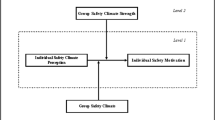Abstract
Management safety commitment is an important theoretical factor in safety climate measurement and research; however, the influence of co-workers has received less attention. This study investigated whether co-worker safety attitudes and behaviours contributed explanatory variance to associations with burnout or whether management attitudes and behaviours primarily determine this association. Hospitality employees (N = 111) completed safety climate, psychosocial safety climate (PSC), and burnout measures. Results showed safety climate was significantly correlated with personal, work and customer-related burnout. Multiple regressions showed co-worker factors did not add predictive capacity for burnout above management factors, although did for determining whether workers experienced customer-related burnout. Results were compared to findings for Disability Support Workers where co-worker factors added predictive capacity above management factors for burnout. Findings suggested worker and manager safety-related attitudes and behaviours are important theoretical components of safety climate, but their relative influence varies according to the safety climate measure used and organisational structure.
Access this chapter
Tax calculation will be finalised at checkout
Purchases are for personal use only
Similar content being viewed by others
References
Australian Government Department of Employment. (2016). Industry employment projections report. Retrieved from http://lmip.gov.au/default.aspx?LMIP/EmploymentProjections.
Andriessen, J. (1978). Safe behaviour and safety motivation. Journal of Occupational Accidents, 1, 363–373.
Becker, T. E. (1992). Foci and bases of commitment: Are they distinctions worth making? Academy of Management Journal, 35, 232–244.
Beus, J. M., Payne, S. C., Bergman, M. E., & Arthur, W. (2010). Safety climate and injuries: An examination of theoretical and empirical relationships. Journal of Applied Psychology, 95(4), 713–727. https://doi.org/10.1037/a0019164.
Brown, R. L., & Holmes, H. (1986). The use of a factor-analytic procedure for assessing the validity of an employee safety climate model. Accident Analysis and Prevention, 18(6), 455–470.
Cheyne, A., Cox, S., Oliver, A., & Tomás, J. M. (1998). Modelling safety climate in the prediction of levels of safety activity. Work & Stress, 12(3), 255–271. https://doi.org/10.1080/02678379808256865.
Christian, M., Bradley, J., Wallace, J., & Burke, M. (2009). Workplace safety: A meta-analysis of the role of person and situation factors. Journal of Applied Psychology, 94(5), 1103–1127.
Clarke, S. (2010). An integrative model of safety climate: Linking psychological climate and work attitudes to individual safety outcomes using meta-analysis. Journal of Occupational and Organizational Psychology, 83(3), 553–578. https://doi.org/10.1348/096317909x452122.
Clarke, S. (2006). Safety climate in an automobile manufacturing plant. Personnel Review, 35(4), 413–430. https://doi.org/10.1108/00483480610670580.
Clarke, S., & Cooper, C. L. (2004). Manageing the risk of workplace stress. London: Routledge.
Cox, S. J., & Cheyne, A. J. T. (2000). Assessing safety culture in offshore environments. Safety Science, 35, 111–129.
Dedobbeleer, N., & Beland, F. (1991). A safety climate measure for construction sites. Journal of Safety Research, 22, 97–103.
Flin, R., Mearns, K., Gordon, R., & Fleming, M. (1996). Risk perception by offshore workers on UK oil and gas platforms. Safety Science, 22, 131–145.
Flin, R., Mearns, K., O’Connor, P., & Bryden, R. (2000). Measuring safety climate: Identifying the common features. Safety Science, 34, 177–192.
Griffin, M. A., & Neal, A. (2000). Perceptions of safety at work: A framework for linking safety climate to safety performance, knowledge, and motivation. Journal of Occupational Health Psychology, 5, 347–358.
Guldenmund, F. W. (2000). The nature of safety culture: A review of theory and research. Safety Science, 34, 215–257.
Guthrie, R., Ciccarelli, M., & Babic, A. (2010). Work-related stress in Australia: The effects of legislative interventions and the cost of treatment. International Journal of Law and Psychiatry, 33, 101–115.
Hall, G. B., Dollard, M. F., & Coward, J. (2010). Psychosocial safety climate: Development of the PSC-12. International Journal of Stress Management, 17(4), 353–383.
Hofmann, D. A., & Stetzer, A. (1996). A cross-level investigation of factors influencing unsafe behaviours and accidents. Personnel Psychology, 49, 307–339.
Kines, P., Lappalainen, J., Mikkelsen, K. L., Olsen, E., Pousette, A., Tharaldsen, J., … Törner, M. (2011). Nordic safety climate questionnaire (NOSACQ-50): A new tool for diagnosing occupational safety climate. International Journal of Industrial Ergonomics, 41, 634–646.
Kristensen, T., Borritz, M., Villadsen, E., & Christensen, K. (2005). The Copenhagen burnout inventory: A new tool for the assessment of burnout. Work and Stress, 19(3), 192–207.
Mearns, K., Whitaker, S. M., & Flin, R. (2003). Safety climate, safety management practice and safety performance in offshore environments. Safety Science, 41, 641–680. https://doi.org/10.1016/s0959-8049(03)00363-0.
Medibank Private. (2008). The cost of workplace stress in Australia. Retrieved from http://www.medibank.com.au/client/documents/pdfs/The-cost-of-Workplace-stress.pdf.
Nielsen, K., & Mikkelsen, K. (2007). Predictive factors for self-reported occupational injuries at 3 manufacturing plants. Safety Science Monitor, 11(2).
Oliver, A., Cheyne, A., Tomas, J. M., & Cox, S. (2002). The effects of organizational and individual factors on occupational accidents. Journal of Occupational and Organizational Psychology, 75, 473–488.
Safe Work Australia. (2013). The incidence of accepted workers’ compensation claims for mental stress in Australia. Retrieved from http://www.safeworkaustralia.gov.au/sites/swa/about/publications/pages/workers-compensation-claims-for-mental-stress-in-australia.
Safe Work Australia. (2015). The cost of work-related injury and illness for australian employers, workers and the community: 2012–13. Retrieved from http://www.safeworkaustralia.gov.au/sites/SWA/about/Publications/Documents/940/cost-of-work-related-injury-and-disease-2012-13.docx.pdf.
Siu, O.-L., Phillips, D. R., & Leung, T.-W. (2004). Safety climate and safety performance among construction workers in Hong Kong. Accident Analysis and Prevention, 36(3), 359–366. https://doi.org/10.1016/s0001-4575(03)00016-2.
Tomas, J. M., Melia, J. L., & Oliver, A. (1999). A cross-validation of a structural equation model of accidents: Organisational and psychological variables as predictors of work safety. Work & Stress, 13, 49–58.
Zohar, D. (1980). Safety climate in industrial organisations: Theoretical and applied implications. Journal of Applied Psychology, 65, 96–102.
Author information
Authors and Affiliations
Corresponding author
Editor information
Editors and Affiliations
Rights and permissions
Copyright information
© 2018 Springer Nature Singapore Pte Ltd.
About this paper
Cite this paper
Heffernan, C., Harries, J., Kirby, N. (2018). Theoretical Components of Workplace Safety Climate and Their Implications for Practice. In: Leung, MT., Tan, LM. (eds) Applied Psychology Readings. Springer, Singapore. https://doi.org/10.1007/978-981-10-8034-0_13
Download citation
DOI: https://doi.org/10.1007/978-981-10-8034-0_13
Published:
Publisher Name: Springer, Singapore
Print ISBN: 978-981-10-8033-3
Online ISBN: 978-981-10-8034-0
eBook Packages: Behavioral Science and PsychologyBehavioral Science and Psychology (R0)




